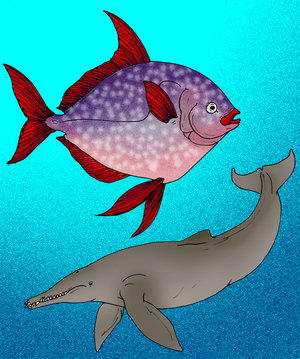
The Oligocene is a geologic epoch of the Paleogene Period that extends from about 33.9 million to 23 million years before the present. As with other older geologic periods, the rock beds that define the epoch are well identified but the exact dates of the start and end of the epoch are slightly uncertain. The name Oligocene was coined in 1854 by the German paleontologist Heinrich Ernst Beyrich from his studies of marine beds in Belgium and Germany. The name comes from Ancient Greek ὀλίγος (olígos) 'few' and καινός (kainós) 'new', and refers to the sparsity of extant forms of molluscs. The Oligocene is preceded by the Eocene Epoch and is followed by the Miocene Epoch. The Oligocene is the third and final epoch of the Paleogene Period.

The Paleogene Period is a geologic period and system that spans 43 million years from the end of the Cretaceous Period 66 Ma to the beginning of the Neogene Period 23.03 Ma. It is the first period of the Cenozoic Era and is divided into the Paleocene, Eocene, and Oligocene epochs. The earlier term Tertiary Period was used to define the time now covered by the Paleogene Period and subsequent Neogene Period; despite no longer being recognized as a formal stratigraphic term, "Tertiary" still sometimes remains in informal use. Paleogene is often abbreviated "Pg", although the United States Geological Survey uses the abbreviation "Pe" for the Paleogene on the Survey's geologic maps.

Nothofagus, also known as the southern beeches, is a genus of 43 species of trees and shrubs native to the Southern Hemisphere in southern South America and east and southeast Australia, New Zealand, New Guinea, and New Caledonia. The species are ecological dominants in many temperate forests in these regions. Some species are reportedly naturalised in Germany and Great Britain. The genus has a rich fossil record of leaves, cupules, and pollen, with fossils extending into the late Cretaceous period and occurring in Australia, New Zealand, Antarctica, and South America.

Crocodylus is a genus of true crocodiles in the family Crocodylidae.
Oligopithecus is a fossil primate that lived in Africa during the Early Oligocene. It is represented by one species, Oligopithecus savagei, known from one jaw bone found in Egypt.

Megistotherium is an extinct genus of hyaenodont belonging to the family Hyainailouridae that lived in Africa.

Waipatia is an extinct genus of odontocetes from the late Oligocene (Chattian) of New Zealand.

The Purpurinidae are an extinct family of sea snails, marine gastropod molluscs in the order Neogastropoda.
Kahawamys is an extinct genus of thryonomyoid rodent which existed in Nsungwe Formation, Tanzania during the late Oligocene. It was first named by Nancy J. Stevens, Patricia A. Holroyd, Eric M. Roberts, Patrick M. O'connor and Michael D. Gottfried in 2009 and the type species is Kahawamys mbeyaensis.
Tanzanonautes tuerkayi is a species of fossil freshwater crab from Tanzania, the only species in the genus Tanzanonautes. It is the oldest known freshwater crab, and probably dates from the Oligocene; the next oldest specimens are from the Miocene. A number of fragmentary remains were discovered in the Songwe Valley part of the East African Rift in Mbeya Region, Tanzania, in fragile sandstone sediments. The animal had a carapace around 50 millimetres (2.0 in) across the widest part, which is around 15 mm (0.6 in) from the front of the carapace; the carapace is 44 mm (1.7 in) from front to back, and the slightly inward-curving rear edge of the carapace is 28 mm (1.1 in) across. The genus name refers to Tanzania, the country where the fossil was found, while the specific epithet commemorates Michael Türkay, an authority on freshwater crabs. The genus Tanzanonautes is assigned to the family Potamonautidae, although the characters mentioned in the family's diagnosis are missing from the fragmentary fossils available.

Cymatoceras is a wide-ranging extinct genus from the nautilitacean cephalopod family, Cymatoceratidae. They lived from the Late Jurassic to Late Oligocene, roughly from 155 to 23 Ma.
The Rukwa Rift Basin, located in southwestern Tanzania, is an endorheic rift basin that contains Lake Rukwa. It forms part of the East African Rift system and has produced a number of Cretaceous and Oligocene fossils.

Rollulinae is a bird subfamily containing the jungle and wood partridges. They are the most basal member of the family Phasianidae, having diverged during the late Eocene or early Oligocene, about 30-35 million years ago. Many taxonomists formerly placed this subfamily within the Perdicinae, but more recent studies have affirmed its existence, and it is accepted by taxonomic authorities such as the International Ornithological Congress.

Hyaenodonta is an extinct order of hypercarnivorous placental mammals of clade Pan-Carnivora from mirorder Ferae. Hyaenodonts were important mammalian predators that arose during the early Paleocene in Europe and persisted well into the late Miocene.
The Galula Formation is a geological formation located south of Lake Rukwa in Tanzania, part of the Red Sandstone Group of the Rukwa Rift Basin. Along with the unconformably overlying Oligocene Nsungwe Formation. It is divided into two members, the lower Mtuka Member and the upper Namba Member.
The Nsungwe Formation is a formation in the Rukwa Rift Basin of the East African Rift System, it is Oligocene in age based on U-Pb dating of a tuff horizon within the formation. It is part of the Red Sandstone Group along with the uncomfortably underlying Mid-Cretaceous Galula Formation It is divided into two members, the lower Utengule Member, and the upper Songwe member. It is notable for being one of the most important Paleogene fossil deposits in Sub-Saharan Africa.
Taubatherium is an extinct genus of mammal, belonging to the order Notoungulata. It lived during the Late Oligocene, in what is today Brazil, in South America.

Apterodontinae is an extinct subfamily of hyainailourid hyaenodonts that lived in Africa and Europe during the late Eocene to middle Oligocene.
Rukwalorax is an extinct genus of hyrax that inhabited Africa during the Oligocene epoch. It is a monotypic genus that contains the single species Rukwalorax jinokitana.










